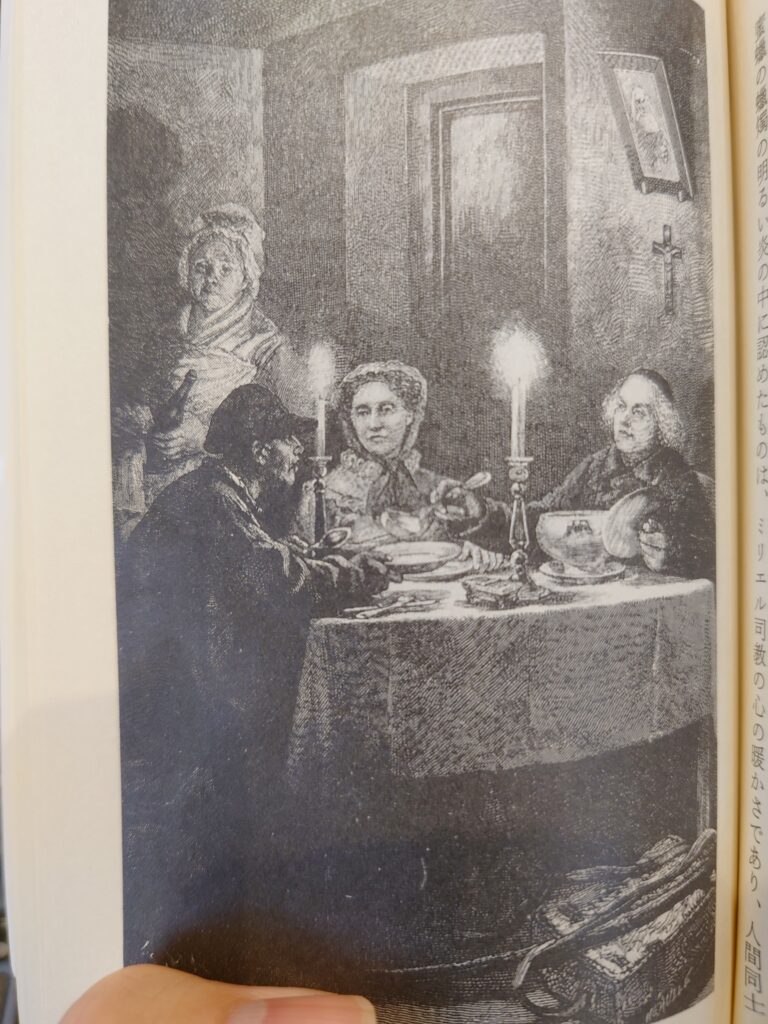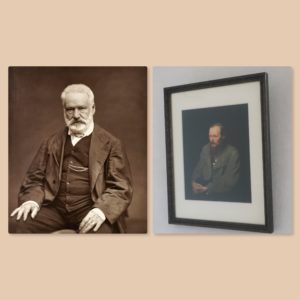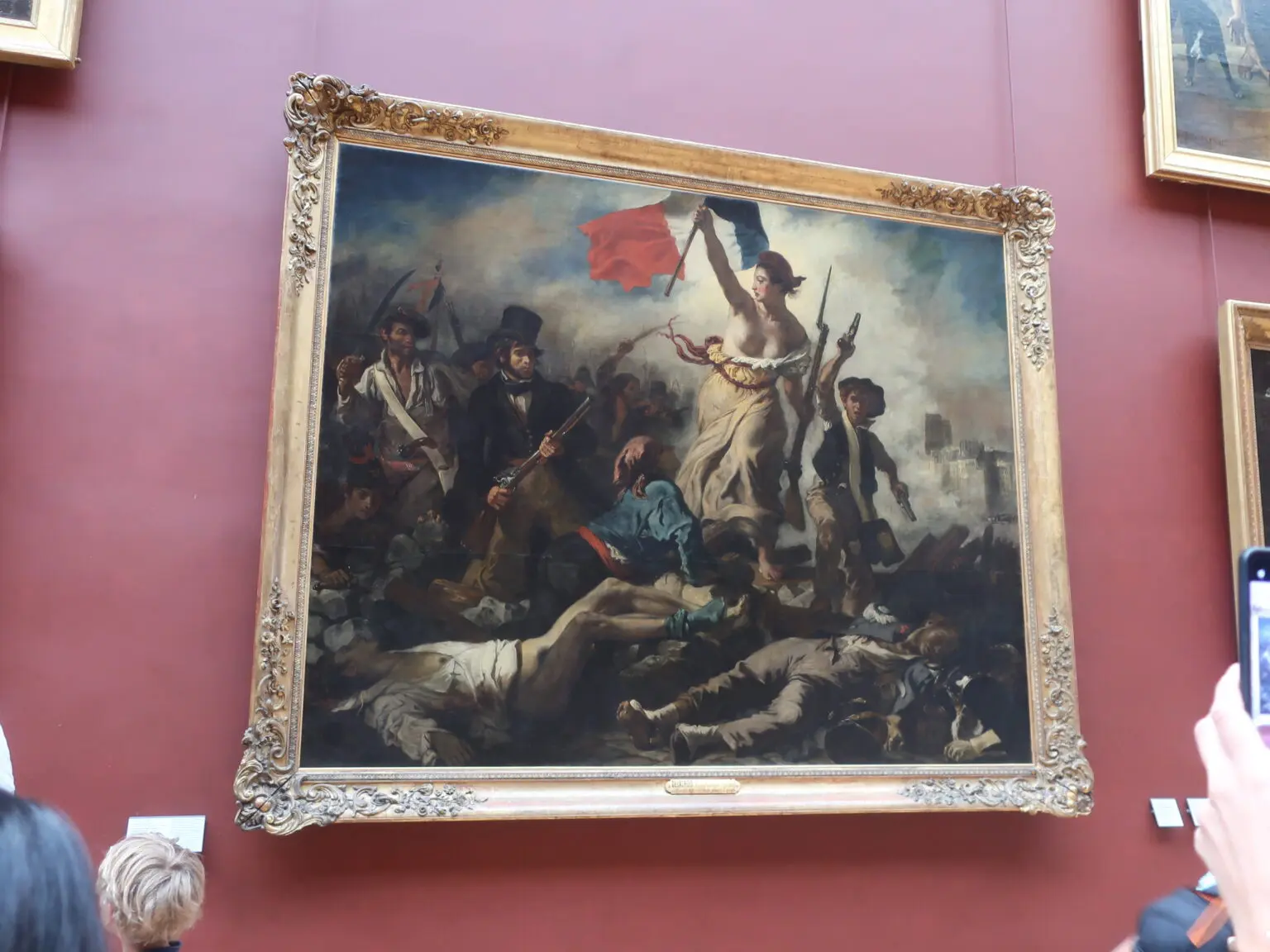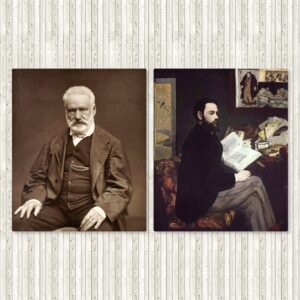ジャン・バルジャンを救ったミリエル司教とは?レミゼの光とも言うべき善良すぎる司教をご紹介

ジャン・バルジャンを救ったミリエル司教とは? 鹿島茂著『「レ・ミゼラブル」百六景』より
今回の記事から鹿島茂著『「レ・ミゼラブル」百六景』を参考に、ミュージカル鑑賞に役立つキャラクター解説をしていきます。

ミュージカルでは時間の都合上、表現しきれない箇所がどうしても出てきてしまいます。そこでより深くレミゼを知るためにユゴーの原作をたよりにしながらそれぞれのキャラクターを見ていきたいと思います。
原作ではジャン・ヴァルジャンと表記されていますが、今回からミュージカルに合わせてジャン・バルジャンと表記していきます。
ミリエル司教とは何者か
今回は『レ・ミゼラブル』の主人公ジャン・バルジャンを救ったミリエル司教とは何者かということについてお話ししていきます。
わずか一片のパンを盗んだために、19年間の監獄生活を送ることになった男、ジャン・バルジャン。
ジャン・バルジャンという名を聞けば、おそらくほとんどの人が「あぁ!聞いたことある!」となるのではないでしょうか。この人ほど有名な主人公は世界中見渡してもなかなかいないかもしれません。
ミュージカルや映画では上の映像のように、ジャン・バルジャンの徒刑場でのシーンからこの物語はスタートします。
そして釈放されたジャン・バルジャンが放浪し、民衆からひどい扱いを受け絶望していた時に出会うのが今回ご紹介するミリエル司教です。
不信や憎しみで荒みきっていたジャン・バルジャンを温かく迎え入れ、盗みを犯した彼に銀の燭台まで与えたミリエル司教。そんな司教の大きな慈悲によって彼は改心します。
ミュージカルや映画では時間の都合上、割とさくっと進んでしまうのですがこれを原作で読んでいくと驚きの展開が待っています。
以前の記事『レ・ミゼラブル㈠ 第一部 ファンチーヌ』あらすじ感想―偉大なる主人公ジャン・ヴァルジャンとは!でもそのことをお話しましたのでその箇所を引用します。
この本を読み始めてみると、驚きの展開が待っています。
なんと、主人公のジャン・ヴァルジャンがまったく出てこないです。
この作品で最初に描かれるのはミリエル司教という人物。
彼は高潔な高位聖職者で、一言で言うならばいい人過ぎるほどいい人なのです。
この物語は最高に善良な司教ミリエル氏がいかなる人物であるかというお話からスタートします。
彼はいつも自分の手元にあるお金のほとんどを貧しい人たちに分け与え、人知れず街のために身を捧げます。
そんな彼の善良さを語る物語がなんと、111ページまで続きます。
つまり、主人公が登場するまでに100ページ以上も一見ストーリーとは全く関係なさそうな司教のエピソードを見せられることになるのです。
ミュージカルや舞台ではこのくだりはカットされていて知ることはありません。
ですがこのミリエル司教こそ、19年間の監獄生活で身も心も荒みきっていたジャン・ヴァルジャンの生き方を決定的に変える人物であり、彼の存在がなければ後のジャン・ヴァルジャンはありえないというほどの重要人物なのです。
映画ではいきなり現れてジャン・ヴァルジャンを救いますが、原作では100ページ以上もかけてミリエル司教の人柄を私たちは見つめることになります。
それによってジャン・ヴァルジャンが救われた瞬間の重みがまさに100ページ分強まるのです。
ミリエル司教がいかに偉大な人物か、そして絶望に苦しむジャン・ヴァルジャンの心の葛藤、そして救い。
この辺りの描写が余すことなく原作では描かれています。
『レ・ミゼラブル㈠ 第一部 ファンチーヌ』あらすじ感想―偉大なる主人公ジャン・ヴァルジャンとは!
なんと、原作では始まってから100ページ以上も主人公のジャン・バルジャンが登場しません。
上の記事ではミリエル司教についてはこれ以上はお話ししませんでしたが、『「レ・ミゼラブル」百六景』では次のように書かれています。
『レ・ミゼラブル』は、十九世紀の多くの長編小説とおなじく、悠揚せまらざる調子で、物語とは一見関係なさそうに思えるディーニュの司教、シャルル=フランソワ=ビヤンヴニュ・ミリエルの生涯の叙述から始まる。徒刑場から解放されたジャン・ヴァルジャンに更生のきっかけを与えることになるこのミリエル司教の人柄を表わすには、ただ一言「慈愛」という言葉があれば足りるだろう。彼はひたすら人間の良心を信じ、嘆き苦しもものには誰にでも救いの手を差し延べたが、あまりにも慈悲深いその人物像は今日の読者の目にはかえって不自然な感じにうつるかもしれない。
ところが、事実は小説より奇なりという定説どおり、このミリエル司教には実在のモデルがいた。すなわち実際にディーニュの司教をつとめたシャルル=フランソワ=メルシオール=ビヤンヴニュ・ド・ミオリスがその人である。この実在のミオリス司教は作中のミリエル司教同様、まったく私心のない篤実温厚な人物だったといわれる。たとえば当時のある知事は「ディーニュの司教殿は八十過ぎの老人で、その蒙昧無知ぶりは司教区で語り草になっているほどですが、慈悲深さと心の純真さによってすべての人々の尊敬を受けています」と語っている。
文藝春秋、鹿島茂『「レ・ミゼラブル」百六景』P20-22
「慈愛」そのものと言える人、ミリエル司教。この人物に実在のモデルがいたというのは驚きですよね。
そして鹿島氏は続けます。
ところで、カトリックの位階制度というものになじみの薄いわれわれ日本人は、司教といわれてもこれがどれくらい偉いのか見当がつかないかもしれないが、司教はフランス全土でも百人前後しかいないのだから、かなり偉いのである。
ちなみに、司祭が村長、大司教が現在の地域圏知事に相当すると仮定すると、その中間の司教はさしずめ今の県知事にあたる。ただ、物語の始まる第一帝政から王政復古にかけての時代には聖職者は役人に比べてかなり優遇されていたから、県知事よりも待遇ははるかによかった。ミリエル司教は広壮な司教館を与えられたうえ、国家から中央官庁の局長クラスの年一万五千リーヴル(約千五百万円)の俸給を支給されていた。
しかし、ミリエル司教はこの豪華な司教館を慈善病院に転用して、自分たち(彼と妹と家政婦)は元の粗末な慈善病院にすみ、俸給のほとんどを貧民の救済や囚人の更生に充て、私用には年千リーヴル(百万円)だけを使うことにしていた。彼はこれに妹の終身年金五百リーヴル,(五十万円)を合わせて年千五百リーヴル(百五十万円)で暮らしていたが、この生活費は当時の平役人のそれに相当するきわめてつましいものである。
文藝春秋、鹿島茂『「レ・ミゼラブル」百六景』P22
原作ではミリエル司教の善良さが100ページ以上も語られますがその中でも特に重要な部分がこちらになります。鹿島氏がまとめたようにミリエルは贅沢をしようと思えばできる立場にいましたが、苦しむ人々のためにそのお金を使い、自分はつましい生活をしていたのでありました。
この事実を知っているか知らないかで、ミュージカルや映画で見るミリエル司教像がまた変わってくるのではないかと思います。
ミリエル司教の罪へのまなざし~死刑反対を訴えるユゴーの体験
ミリエル司教はなぜ元徒刑囚のジャン・バルジャンを温かく迎え入れたのか、そして窃盗をした彼を許し、あまつさえ銀の食器類を与えまでしたのか。その背景を見ていきます。
第一部・第一章の「正しい人」には、教誨師の代理として死刑の執行に立ち会ったミリエル司教が大きな衝撃をうけるところがある。ミリエル司教は自問する。「死は神にのみ属するものだ。人間たちはなんの権利があってこの未知なるものに触れようとするのか」
じつは、こうしたミリエル司教のショックはユゴー自身のものにほかならない。
ユゴー夫人の証言を信じるなら、ユゴーは、一ハニ〇年、べリー公暗殺犯ルヴェルがギロチンに送られる姿を目撃して「暗殺犯に対する憎しみが死刑囚への哀れみに変わるのを感じた」と言う。
このときの衝撃は、九年後の一ハニ九年、匿名で死刑制度弾劾の書『死刑囚最後の日』を出版する直接のきっかけとなった。豊島与志雄の訳によって日本でも古くから知られるこの小説は、死刑の判決を受けてからギロチンに送られるまでの一死刑囚の苦悶を死刑囚本人の手記という形で克明に描き出したものであるが、そこには、ビセートルの監獄、トゥーロンの徒刑場に護送される囚人の群れ、後に残された家族の悲惨、囚人たちの使う隠語など、のちに『レ・ミゼラブル』であつかわれる主題の多くが現われている。
文藝春秋、鹿島茂『「レ・ミゼラブル」百六景』P24-26
ミリエル司教は死刑執行へのショックは実はユゴーその人が感じたものでもありました。ここで紹介されている『死刑囚最後の日』は以前当ブログでも紹介しましたのでぜひご参照ください。

話は戻るが、ユゴーはこの「正しい人」の一節の最後で、「時がたつうちにこうした印象は薄らぎ、おそらくは消え去ってしまったにちがいない。だが、それからのちも人々は司教が処刑場を避けて通ることに気づいた」とさりげなく書きとめている。じつはこの箇所はミリエル司教の慈悲深さを示すどんな挿話よりも重要なものと思われる。その理由はほかでもない、前ページの挿絵である。ユーグ版『レ・ミゼラブル』の各章の最初にはその章のエッセンスを示す挿絵がついているが、「正しい人」の章の扉絵は、この断頭台で死刑囚を慰めるミリエル司教の図にほかならない。要するに、銀の食器を盗んだジャン・ヴァルジャンをミリエル司教が許す伏線はここに置かれているのだ。
一般には、ミリエル司教はキリスト教精神の理想像と見なされているが、むしろ、ユゴー的な社会観を体現した人物と考えたほうがいい。というのも更生したジャン・ヴァルジャンがキリスト教の伝道者ではなく、社会事業家マドレーヌ氏に変身するのを見ても明らかなように、ユゴーは、新しい社会で人々を導くには、魂の救済者であるで同時に社会の改革者でなければならないと考えていたからである。
文藝春秋、鹿島茂『「レ・ミゼラブル」百六景』P26
なぜミリエル司教はジャン・バルジャンを許すのか。それは彼の死刑への念、つまり罪と罰に対する思いがあったからでした。罪を犯した人間を断罪し、救いようのない人間とみなすのか。悲惨な環境に置かれたが故に罪を犯してしまった人間に対してもそうした断罪は適当なのか。
いや、どんな人間でも生まれ変わることができる。魂の救済こそ、キリスト者の道であることをミリエル司教はその生き様で示すのでありました。
こうしたミリエル司教に出会ったからこそ、ジャン・バルジャンは救われることができたのです。
こう考えていくとレミゼにおける2人の出会いの意味の大きさが感じられると思います。
ジャン・バルジャンはミリエル司教の慈悲、優しさに触れ救われました。
そしてそのジャン・バルジャンはファンチーヌ、コゼット、マリユスにその慈しみを注ぎ、彼らもジャン・バルジャンに救われることになるのです。
慈しみが世代を超えて引き継がれていくことの大切さをユゴーはこの物語で示しています。
このようなメッセージを伝える上でもミリエル司教の存在はレミゼにおける重要な柱となっています。
ミュージカルではあまり目立たぬ存在ですがジャン・バルジャンの心の中にはいつもミリエル司教の慈悲があります。
荒みきっていたジャン・バルジャンを救ったミリエル司教は単に優しい神父で終わる存在ではありません。長年にわたり人々に尽くしてきた慈悲そのものを体現した圧倒的な存在です。
次の記事ではレミゼの主人公、ジャン・バルジャンの過去を見ていきます。
以上、「ジャン・バルジャンを救ったミリエル司教とは?鹿島茂著『「レ・ミゼラブル」百六景』より」でした。
※2023年7月22日追記

ミリエル司教がジャン・ヴァルジャンを救ったエピソードとして銀の燭台が有名ですが、この燭台とロウソクについて鹿島茂先生が『パリ時間旅行』という本の中で非常に興味深い解説をして下さっています。私もこの解説を読み驚愕しました。何気なく描かれるミリエル司教とジャン・ヴァルジャンの食事ですが、ここにミリエル司教の慈悲の深さが詰まっていたのです。ジャン・ヴァルジャンがなぜ司教と出会い改心できたのかがこのエピソードに集約されています。以下の記事でその解説の一部をご紹介していますのでぜひご参照ください。

Amazon商品ページはこちら↓
「レ・ミゼラブル」百六景 レ・ミゼラブル(一)(新潮文庫)次の記事はこちら

前の記事はこちら

関連記事



















コメント